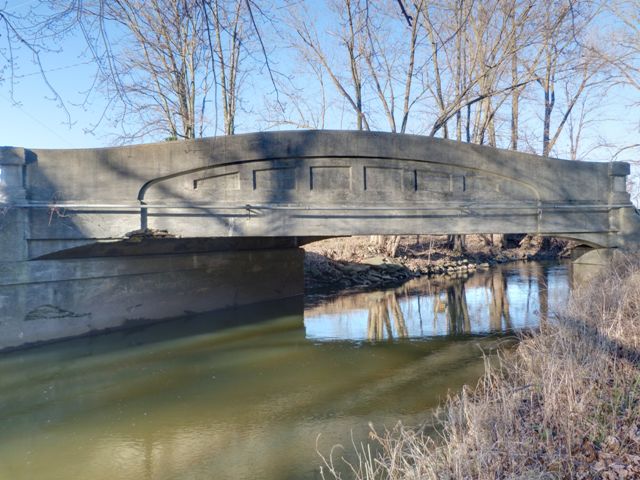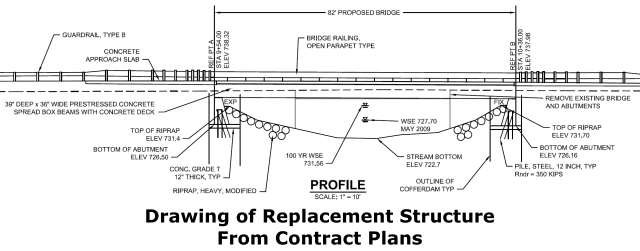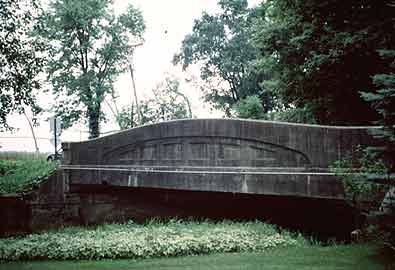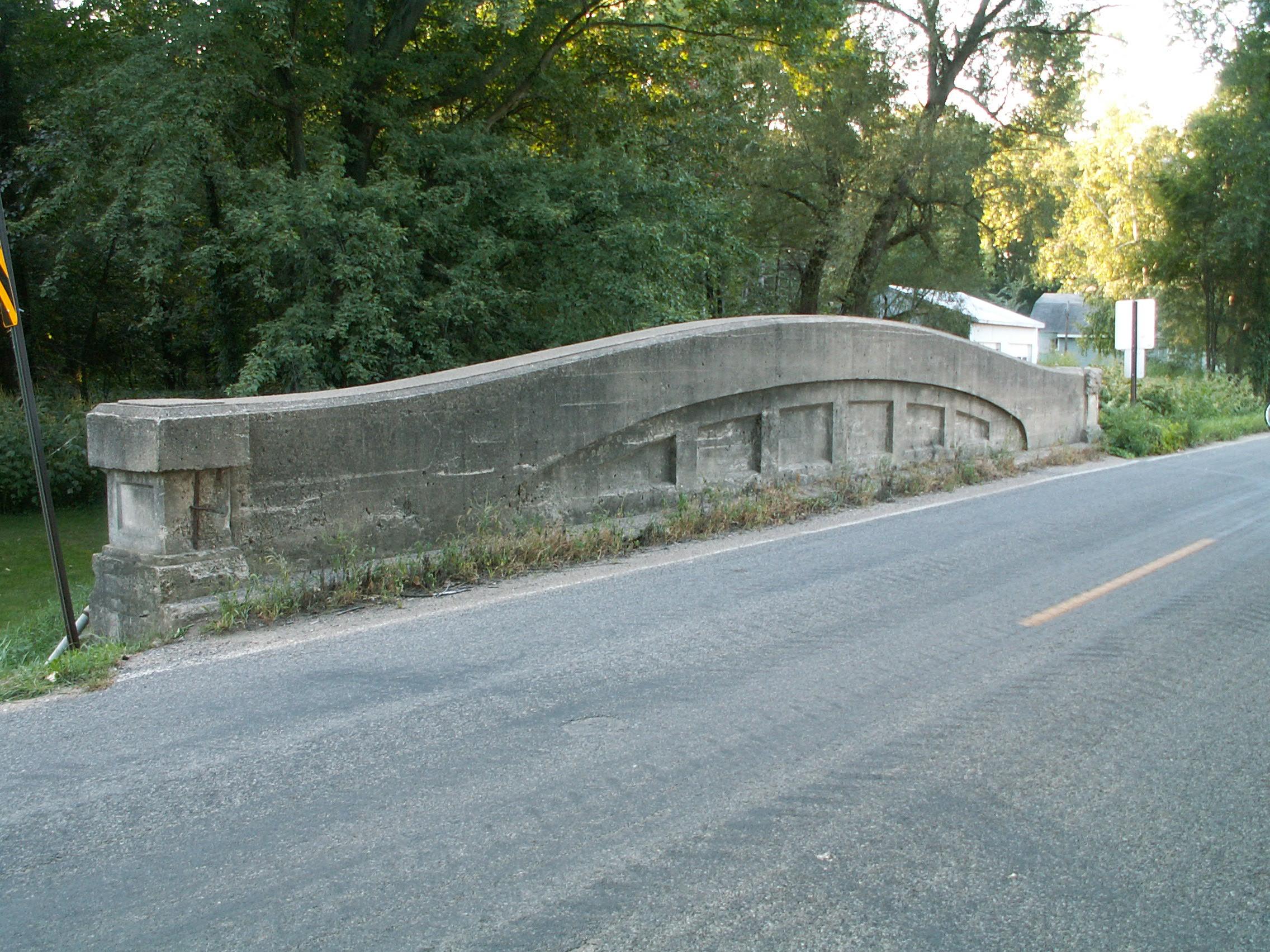We Recommend:
Bach Steel - Experts at historic truss bridge restoration.
BridgeHunter.com Phase 1 is released to the public! - Visit Now
2nd Street Bridge South

Primary Photographer(s): Nathan Holth
Bridge Documented: 2006 and December 26, 2011
Hooper (Rural): Allegan County, Michigan: United States
1926 By Builder/Contractor: Yost Brothers of Decatur, Indiana and Engineer/Design: Michigan State Highway Department
Not Available or Not Applicable
48.0 Feet (14.6 Meters)
50.0 Feet (15.2 Meters)
22 Feet (6.71 Meters)
1 Main Span(s)
03200086000B010

View Information About HSR Ratings
Bridge Documentation
This bridge no longer exists!
View Archived National Bridge Inventory Report - Has Additional Details and Evaluation
This extremely significant historic bridge was demolished and replaced by Allegan County Road Commission in 2012!
Learn about Michigan's Unique Concrete Camelback Bridges
This was a completely different Second Street than the one the truss bridge in Allegan County is on. This bridge was similar in size and style, including its skewed alignment, to the similar bridge a few miles north on this same road. This bridge was extremely significant as a surviving example of a curved chord through girder bridge, commonly called a concrete camelback bridge. A small number of examples remain in Michigan, and only a few states in the entire country ever built any bridges of this type. As such, this bridge type is rare on a statewide and national level. This particular bridge was also significant as being part of a Covert Road, as the plaques on the bridge showed. Read the Historic Bridge Inventory data below for details on the Covert Act. The structure was in relatively good condition, with very little spalling.
With so few remaining examples of this unique and attractive historic bridge type, every effort should be being made to preserve each remaining example. As a bridge associated with an unusual funding program, this bridge was particularly significant. Additionally, the bridge was in decent condition, better than a number of surviving bridges in Michigan. While the road that the bridge was located on was called a "primary" county road, the reported Average Daily Traffic was only 560. This is a very small amount of traffic. The width of the bridge, although narrow for a two-lane bridge compared to modern bridges, was more than sufficient for a quiet county road such as this. Additionally, at 22 feet, this bridge's roadway was wider than many concrete camelback bridges that only have a 20 foot roadway. This was a bridge that deserved preservation. Preservation appears to have been a sensible course of action in terms of the bridge's use and condition.
Despite the above conditions, Allegan County Road Commission made the choice to demolish and replace this historic bridge with a mundane pre-stressed concrete bridge. This is not not only disappointing but is deeply disturbing. It shows a complete lack of interest in the preservation of Michigan's unique historic concrete camelback bridges, even when that preservation is feasible and cost-effective. With so few examples of this bridge type left, each surviving example should be preserved. It is sickening to even think of one of these beautiful historic bridges with a unique appearance that is Michigan's alone would be demolished. These bridges were so heavily overbuilt that their decks have been known to bear heavy loads even after the load-bearing girders are removed. The demolition of this bridge raises serious concerns about the other two concrete camelback bridges in Allegan County. Will the county road commission have a change of heart and choose to commit to the long term preservation of the two remaining examples, or will it choose to annihilate those bridges in the same way, condemning Allegan county to an existence without these beautiful bridges?
Information and Findings From Michigan Historic Bridge Inventory
Narrative Description The Second Street Bridge was built by the Allegan County Road Commission as a covert road bridge in about 1926. The county hired Yost Brothers, contractors from Decatur, Indiana, to erect the structure. The original plans cannot be located, but the design appears to be based on the standard Michigan State Highway Department plan for a curved-chord concrete girder bridge. This structure is a rare example of a bridge with a plate indicating that it was built as part of a covert road. Statement of Significance The Second Street Bridge is eligible for the National Register because it exemplifies the state's pioneering efforts to develop standard plans and implement programs such as the Covert Act. Passed by the state legislature in 1915, the Covert Act required the state, upon request of the appropriate locality, to build all trunk-line roads as well as inter-county non-system roads. Adjacent land owners were assessed for half the cost; road commissions could issue bonds for the remainder. |
![]()
Photo Galleries and Videos: 2nd Street Bridge South
2011 Bridge Photo-Documentation
Original / Full Size PhotosA collection of overview and detail photos, taken December 26, 2011, plus some older photos from 2006 to complete the documentation. This gallery offers photos in the highest available resolution and file size in a touch-friendly popup viewer.
Alternatively, Browse Without Using Viewer
![]()
2011 Bridge Photo-Documentation
Mobile Optimized PhotosA collection of overview and detail photos, taken December 26, 2011, plus some older photos from 2006 to complete the documentation. This gallery features data-friendly, fast-loading photos in a touch-friendly popup viewer.
Alternatively, Browse Without Using Viewer
![]()
Original Bridge Photo-Documentation
A collection of overview and detail photos from 2006 and earlier. This photo gallery contains a combination of Original Size photos and Mobile Optimized photos in a touch-friendly popup viewer.Alternatively, Browse Without Using Viewer
![]()
Maps and Links: 2nd Street Bridge South
This historic bridge has been demolished. This map is shown for reference purposes only.
Coordinates (Latitude, Longitude):
Search For Additional Bridge Listings:
Bridgehunter.com: View listed bridges within 0.5 miles (0.8 kilometers) of this bridge.
Bridgehunter.com: View listed bridges within 10 miles (16 kilometers) of this bridge.
Additional Maps:
Google Streetview (If Available)
GeoHack (Additional Links and Coordinates)
Apple Maps (Via DuckDuckGo Search)
Apple Maps (Apple devices only)
Android: Open Location In Your Map or GPS App
Flickr Gallery (Find Nearby Photos)
Wikimedia Commons (Find Nearby Photos)
Directions Via Sygic For Android
Directions Via Sygic For iOS and Android Dolphin Browser
USGS National Map (United States Only)
Historical USGS Topo Maps (United States Only)
Historic Aerials (United States Only)
CalTopo Maps (United States Only)




